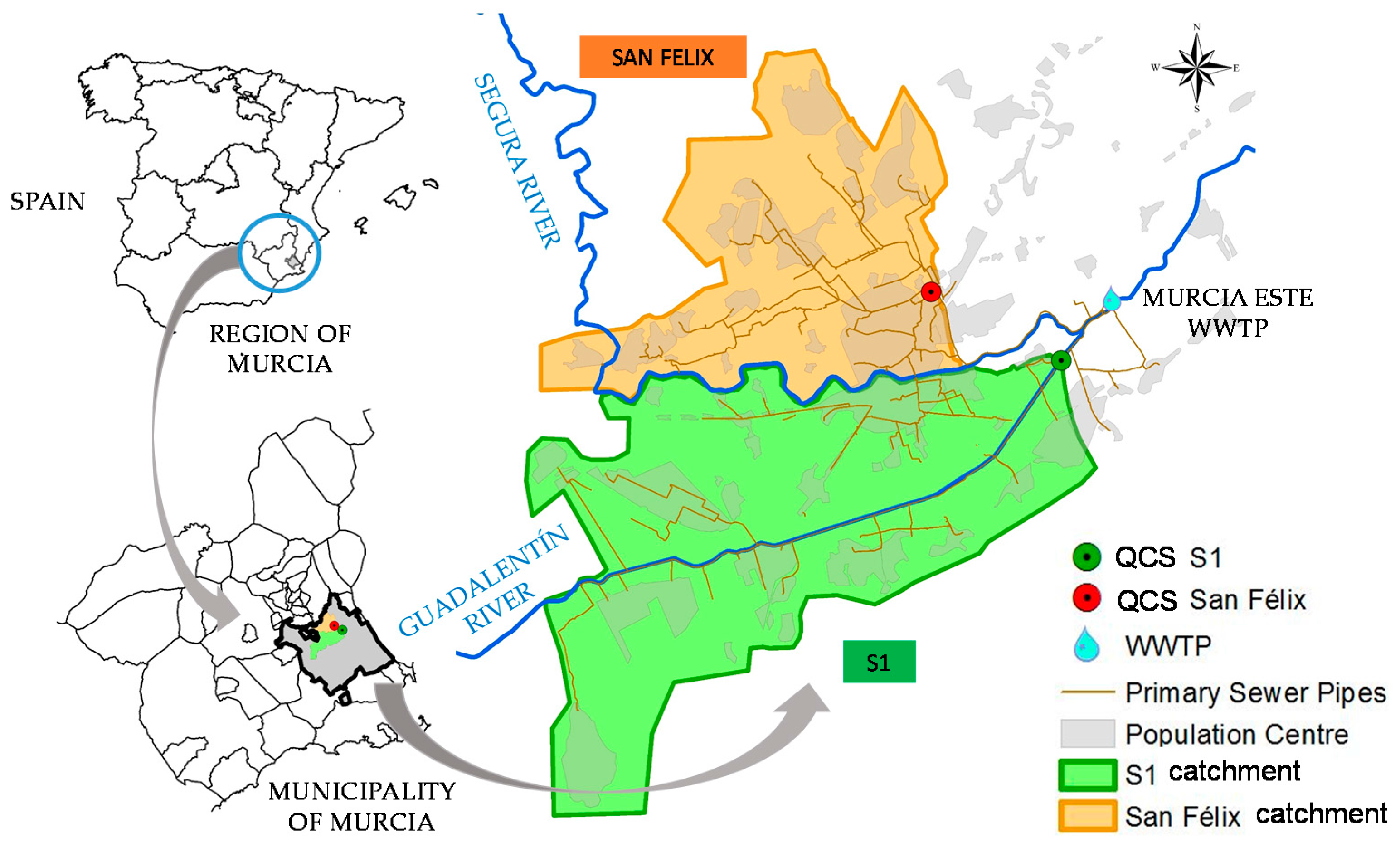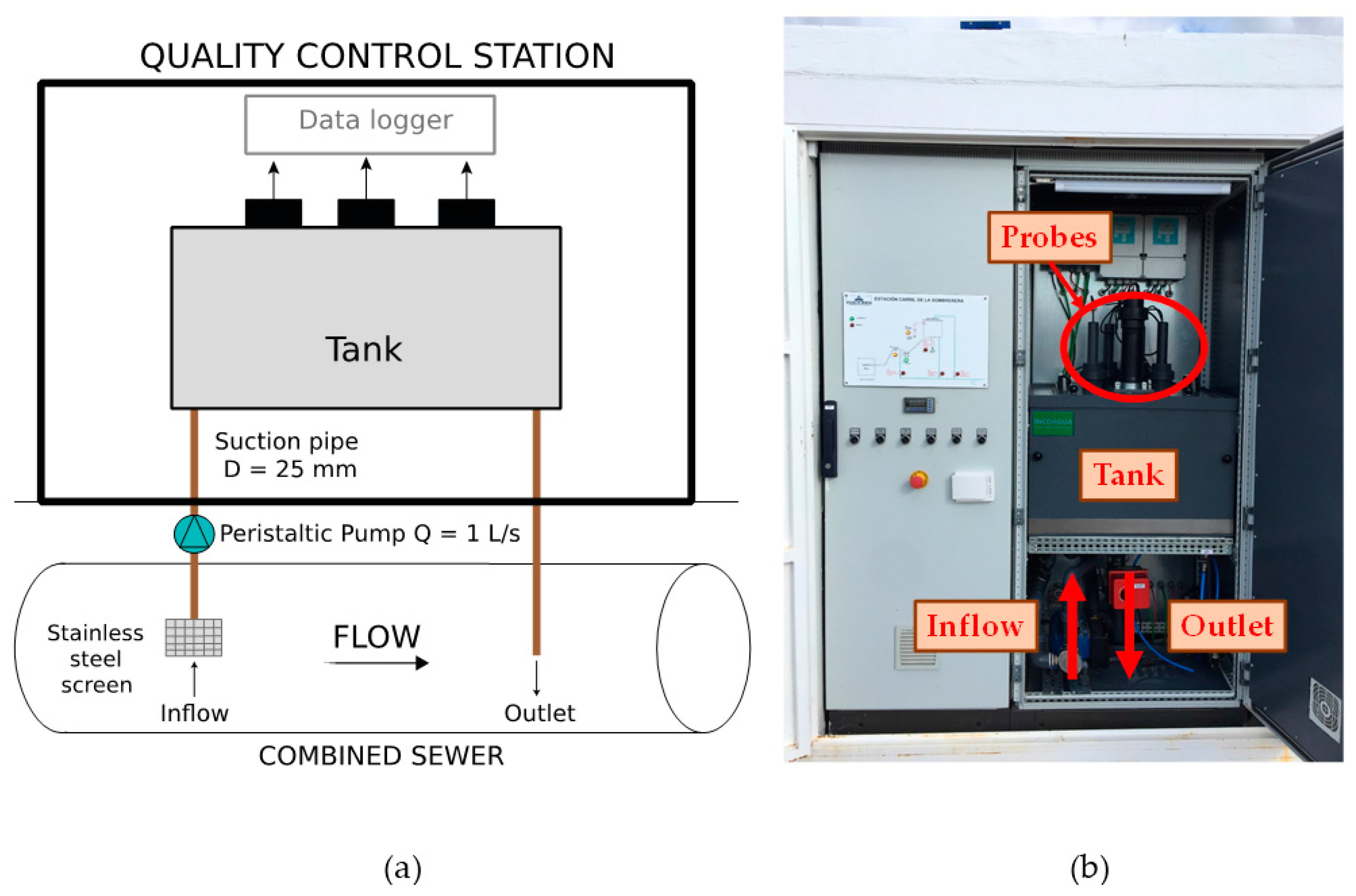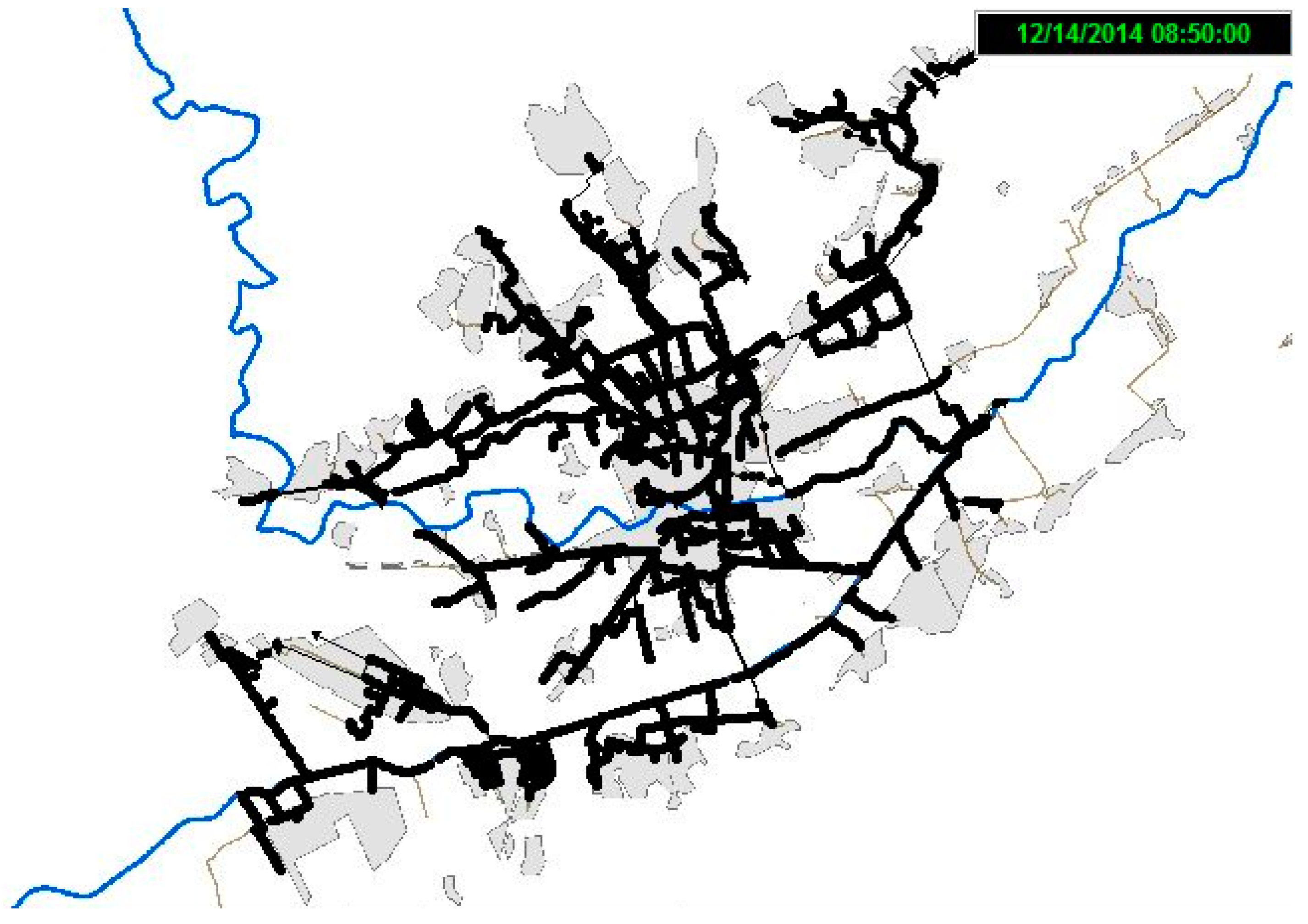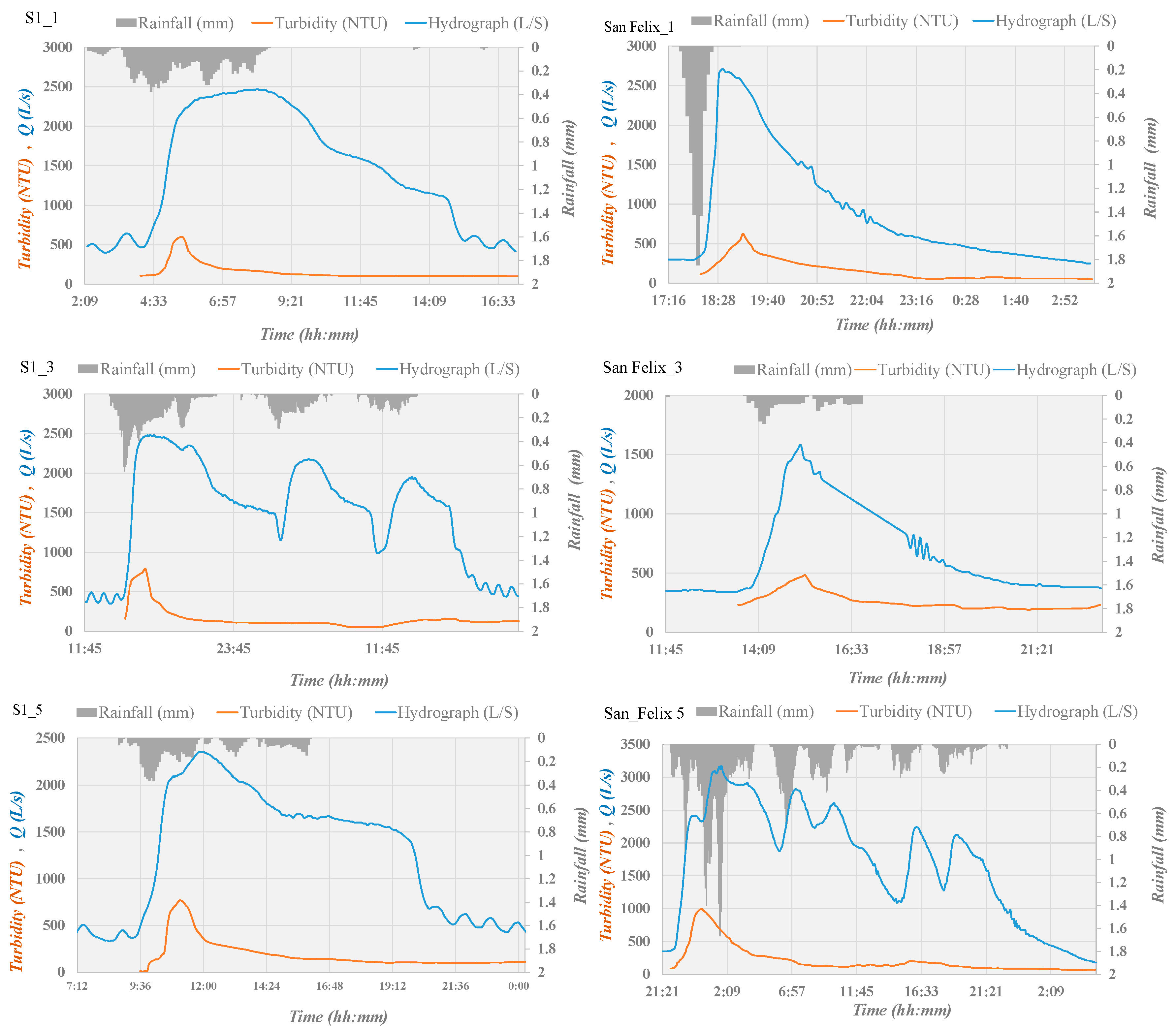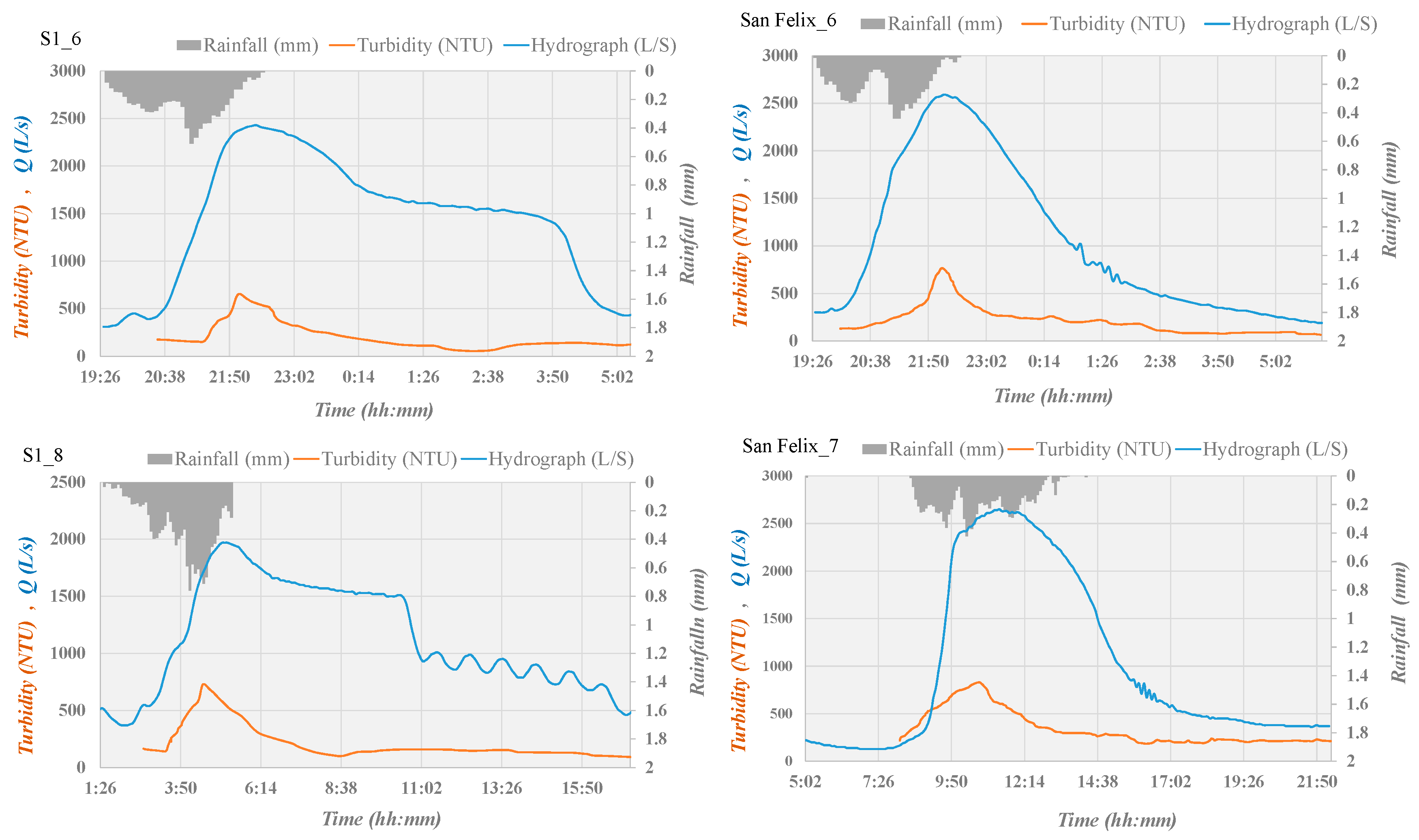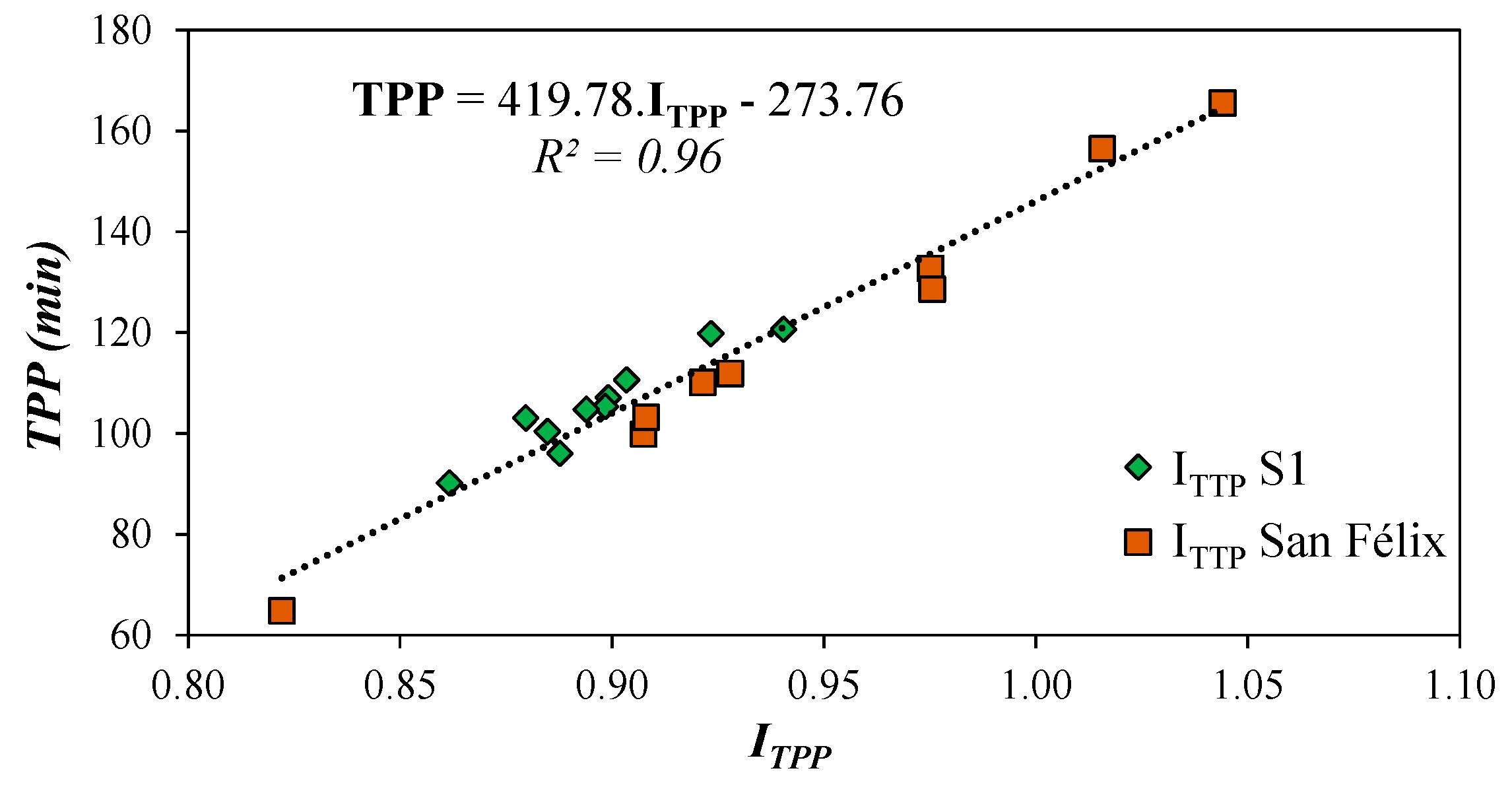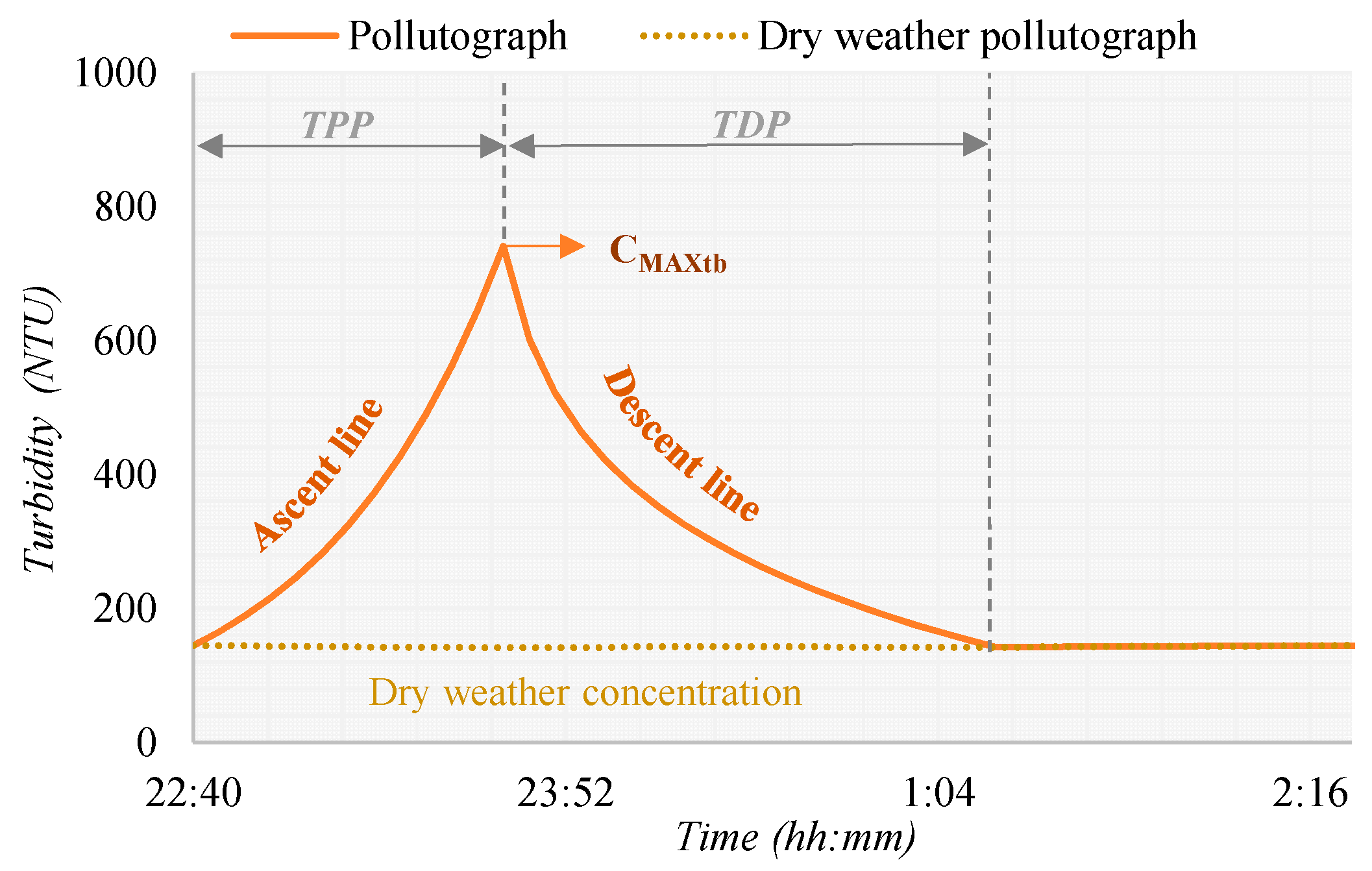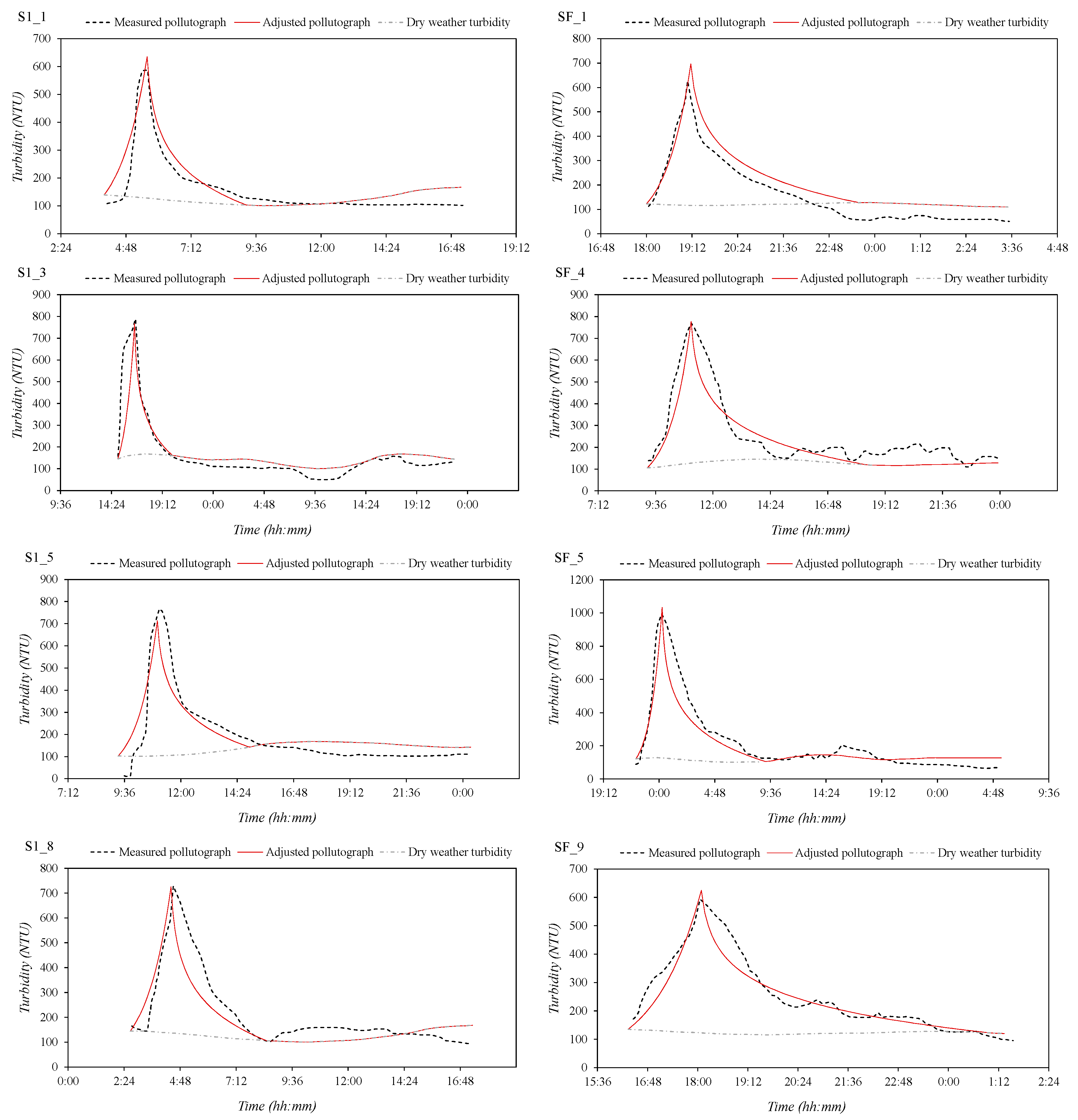1. Introduction
The reduction of pollution emissions from combined sewer overflows (CSOs) is currently a prime issue. Actually, European Directives aim to quantify and reduce them to protect the environment and human health, and to provide water leisure activities and water abstraction for agriculture [
1]. Although a lack of knowledge of the quantity and the quality of these overflows is recognized and policies have yet to be achieved in most countries, important efforts are being done (e.g., [
2,
3,
4,
5]). Risk based approaches are usually implemented taking into account the type of collecting systems and the intensity of the rain events or flooding. Spill frequency, or volume percentage retained, are habitually selected [
4,
6]. Other approach is the receiving water quality criteria, based on Urban Pollution Management procedures (UPM) standards [
5]. It requires being aware of ecological state of receiving water and effects induced by the pollution. Field measurement campaigns of the urban sub-catchment are recommended as a previous step to implement an approach [
3,
7,
8] so that pollution mobilized during rain events can be evaluated.
Continuous water-quality monitoring sensors are being increasingly implemented in sewers. In order to replace traditional sampling, turbidimeters can be used to estimate total suspended solids (TSS) and chemical oxygen demand (COD) concentration in sewers, by linear regression of on-site turbidity with site-specific measurements [
7,
8,
9,
10,
11,
12,
13].
The relationship between pollutant load of TSS and runoff, by statistical approaches, constitutes a field of research to identify pollution associated to CSOs [
7,
14,
15,
16,
17,
18,
19,
20]. In this way, measured hydrographs and pollutographs analysis are used to relate the peak of the pollutant concentration of the flow, and the mass and flow cumulative volume curves
M(
V), which, for instance, allow determining whether the first flush effect exists for a particular catchment [
7,
14,
15,
16,
17]. Suarez and Puertas [
17] fitted the maximum suspended solids concentration (
CMAXSS) by means of probability distributions. With regard to rainy events, several researchers [
7,
18,
19,
20] performed regression analysis between TSS and hydrological and hydraulic variables (
Table 1). These statistical models gave rise to adjusted pollution parameters, which can be used for forecasting transported pollution characteristics along storm events, providing useful information to establish effective policies of combined sewer overflow control. As these studies are usually catchment specific, an important aim would be to define standard coefficients for a wide range of catchment conditions [
18].
For a proper design of sustainable sewer systems, hydraulic and quality modeling tools are utilized [
8,
19,
21]. Hydraulic models, such as USEPA Storm Water Management Model (SWMM) [
22], predict the runoff flow rate and volume from observed rainfall intensities with accuracy. However, for quality models, the uncertainty is an order of magnitude greater than that for the hydraulic submodels [
23]. That makes their calibration and use complex.
In this work, statistical models are proposed to predict the event maximum turbidity concentration (CMAXtb), the time to the peak of the pollutograph (TPP), and the time to the descent of pollutograph (TDP).
The statistical models are based upon analysis of data collected from rainfall events during period from June 2014 to April 2016 at two urban catchments in the city of Murcia (southeast Spain). Both catchments were monitored with continuous measurements from rain gauges, in-sewer turbidimeters and water gauges. Several input parameters of the statistical models were considered to assess their significance, and the most significant parameters were selected. Predicted pollutograph parameters are calculated and modeled. The proposed pollutographs are compared with the measured ones showing a significant agreement. A calibrated hydraulic model of the city of Murcia has been generated in the USEPA Storm Water Management Model (SWMM). The numerical model is used to analyze the catchment hydraulic response to each rainfall event.
The present work provides tools to assist in the knowledge of pollution transported through sewer network during stormy events, suggesting the creation of design pollutographs which may facilitate the evaluation of measures to reduce urban runoff pollution.
3. Results and Discussion
3.1. Variables Definition from Wet Weather Measured Events
The data registered from monitoring rainfall events corresponds to the period from June 2014 to April 2016 at both urban catchments. During this period, 10 storm events were measured in the S1 QCS and 9 in the San Felix QCS.
Measured values are presented in
Table 5 and
Table 6 for San Felix and S1, respectively. All rainfalls exceed the total amount of 2 mm, which is the minimum value to assure runoff.
Several variables have been calculated from the monitored data and are also collected in
Table 5 and
Table 6, such as the total rainfall volume
PTOTAL, the maximum rainfall intensity during ten minutes
Imax10, the mean intensity
Imean, and the number of antecedent dry days
DWP. There are also others parameters such as the maximum runoff flow rate
Qmax, the mean runoff flow rate
Qmean, the time to hydrograph peak
TPH, the total runoff volume
EV, the part of the runoff volume that would correspond to dry weather
EVdw, the difference between both
EVww, the maximum turbidity registered during the episode
CMAXtb, the mean event turbidity value
EMCtb, and the time to the peak of pollutograph
TPP.
These variables have been calculated for all rainfalls, which are hereinafter used to study the correlation among them to adjust statistical models that allow predicting several variables at any rainfall event, e.g., the event maximum turbidity concentration CMAXtb, and the time to the peak of pollutograph TPP.
The hydrographs and turbidity-pollutographs of some of the measured rainfall events are presented in
Figure 5. The pollutograph peak does not always precede the hydrograph one, as can be observed in
Table 5 and
Figure 5 for San Felix Catchment.
The calibrated hydraulic model in SWMM has been used to obtain the hydrographs presented in
Figure 5.
3.2. Predictor Variables Correlations
With the objective of adjusting a statistical model, the correlation between predictor variables has been traced. The chosen predictor variables are
DWP,
Qmax,
TPH,
PTOTAL,
Imax10,
CMAXtb, and
TPP. The correlation matrix is presented in
Table 7 and
Table 8 for S1 and San Felix catchments, respectively. The Pearson’s correlation coefficient has been applied to the sample of each pair of variables. From the matrices, correlation between the time to pollutograph peak,
TPP, and the time to hydrograph peak,
TPH, is observed with values of
R2 = 0.79 and 0.94 for S1 and San Felix, respectively. The dry period preceding the episode,
DWP, and the maximum concentration of turbidity,
CMAXtb, show good relation, especially in the S1 Catchment with
R2 = 0.68. There is also certain relationship between the maximum concentration of turbidity,
CMAXtb, with the total precipitation and the maximum flow in the San Felix Catchment.
3.3. Pollution Prediction Indexes. Statistical Model
From the previous section, the correlation between predictor variables individually analyzed is considered not significant enough to be used as a prediction tool of the pollution in a rainfall event. For this reason, multivariate indexes are proposed. The aim is to predict, on the one hand, the maximum concentration of turbidity during each event, CMAXtb, and, on the other hand, the time elapsed from the beginning of the event until the maximum peak of the pollutograph, TPP. To achieve this, two indexes of prediction are adjusted: the time to peak of the pollutograph index, ITPP, and the maximum concentration index, ICMAX.
3.3.1. Time to the Peak of Pollutograph Index, ITPP
The index time to the peak of the pollutograph will be used to predict the time that elapses from the beginning of the episode until the maximum value of turbidity in the event is reached,
TPP. It can be defined with dimensionless factors:
where
PTOTAL_ANNUAL is the total precipitation expected in a year, adopting 350 mm for this region. In Equation (4), the time to the peak of the hydrograph,
TPH, is considered. Its significant relation with
TPP is shown in the correlation matrices (
Table 7 and
Table 8).
The first term of Equation (4),
TPH/Tc, reflects the time of the catchment to respond as a function of: (i) how the rain is distributed proportionally to
TPH; and (ii) the shape of the catchment inversely proportional to
Tc. The second term,
PTOTAL/PTOTAL_ANNUAL, magnitude of the rainfall, is also proportional to the time to the peak of the pollutograph. In this Equation, the term
PTOTAL/PTOTAL_ANNUAL has lower influence on the index than
TPH/Tc. However, its inclusion improves the adjustment from
R2 = 0.87 to
R2 = 0.96.
Figure 6 shows the linear relationship between the pollutograph time to the peak index, defined in previous equation, and the time to the peak of pollutograph.
In
Figure 6, a linear regression that relates the time index to the peak of the pollutograph and the time to the peak, expressed in minutes, can be obtained as:
3.3.2. Maximum Concentration Index, ICMAX
The maximum concentration index
ICMAX arises with the objective of estimating the maximum concentration of turbidity,
CMAXtb, from predictor variables quantified in rainfall events. Together with the
ITPP, they allow estimating both the magnitude of the pollutograph and the location in time of the higher turbidity. The equation for
ICMAX is defined as
where
DWR is the proportion of consecutive dry weather days previous to the event in the last month. Equation (6) is dimensionless and can be divided into three main terms. The first term is related to the power of the event, where an increase in the total rainfall causes a greater sediment wash. Assuming the rest of parameters fixed, a higher maximum concentration will occur in the catchment with a higher average slope. The second term reflects that during the time without precipitation there is sedimentation and accumulation of deposits along the network that can be washed away during storm events. Finally, the third term is a shape factor of the catchment. It is a catchment geometric parameter defined according to
where
A is the area of the catchment (km
2) and
L is the catchment flow length (km).
Table 9 summarizes the shape factor obtained in both catchments analyzed.
Figure 7 presents the values of
ICMAX, calculated by Equation (6) for each rainfall event, and the maximum of measured turbidity in each event,
CMAXtb. Most values fit around a line except four cases:
- (i)
S1_4: It is an episode with very low precipitation (3 mm). Thus, although the previous dry period is very extensive (24 days), the prediction index yields lower values of the maximum concentration.
- (ii)
S1_9 and S1_10: The measured maximum concentration values are below the trend followed by the other data. The possible reason of this phenomenon seems to be related with the energy of both events. The rains on these two days are characterized by an average intensity of low precipitation (less than 1 mm/h), so that the catchment and the network were slowly washed.
- (iii)
SF_8: It is similar to episode S1_4. The precipitation is very low (2.3 mm).
Those reasons justify discarding the four cases. The relationship between CMAXtb and ICMAX fit to a line with a correlation coefficient of R2 = 0.91.
The fitted line of the adjustment between the maximum concentration index,
ICMAX, and the maximum concentration of turbidity,
CMAXtb, is given by a linear regression
Table 1 summarizes the parameters presented in the literature to predict pollution. This manuscript proposes a new model to estimate
CMAXtb. Moreover, proposed methodology also allows estimating
TPP from hydraulic and hydrological parameters.
3.4. Development of Pollutographs from Prediction Indexes
Pollutograph is the representation of the concentration of a certain pollutant over time. The analysis of the ensemble formed by the hydrograph, the rainfall and the pollutograph of a given event can provide very important information about the mass mobilization of contaminants in an episode. For this reason, the knowledge of this graph is essential for the tasks of pollution management.
Figure 8 presents a standard pollutograph.
The line of ascent can be adjusted to the following exponential equation
where
Na is the number of intervals of 5 min in which the ascent time is divided;
n indicates the interval (0 ≤
n ≤
Na) in units of five minutes; and
Ca and
C0 are the turbidity values at each interval
n and at the beginning of the pollutograph, respectively (measured in NTU). The value of
C0 is assumed as the dry weather value at the beginning of the episode.
Once
CMAXtb and
TPP have been calculated from prediction indexes, the time to the descent of pollutograph,
TDP, can be defined as the time interval between the instant of the maximum concentration and the time when the concentration reaches dry weather values. The time to the descent of pollutograph value has been adjusted for each of the catchments showing a linear relationship with pollutograph time to the peak. The adjustment of
TDP for each catchment is given by
where
TPP and
TDP, in this equation, are expressed in minutes.
Differences between measured and calculated TDP at the studied events present average relative errors below 13% for the S1 catchment and 14% for the San Félix catchment.
The descent line of the pollutographs can be adjusted to a logarithmic function:
where
Nd is the number of intervals of five minutes in which the descent time is divided;
n indicates the interval (
Na ≤
n ≤
Nd) in units of five minutes; and
Cd and
CTStb are the turbidity values at each
n interval and at the end of the event, corresponding to
TDP time, respectively (measured in NTU). Equation (11), when
n =
Na, ln(
n −
Na + 1) = 0, and
Ca =
Cd =
CMAXtb, assures continuity.
Figure 9 shows some of the measured pollutographs. They are compared with the pollutographs obtained by Equations (9)–(11). Results show a good agreement between measured and calculated pollutographs; therefore, the proposed methodology is suitable for estimating pollutographs from indexes.
Several multi-peaked hydrographs have been registered, however none of them led to a multi-peak pollutograph (see case S1_3 and San Felix _5 in
Figure 5). Actually, the flushing produced by the first hydrograph peak leads to the removal of a second peak in the pollutograph. Present methodology also covers multi-peak hydrographs with unique pollutograph peak, according to observed events.
4. Conclusions
Time-continuous measurements of rainfall, in-sewer turbidity and water flow depth have been registered for almost two years. From the measurements, quality and hydraulic rainfall-event variables have been defined (
Table 5 and
Table 6).
In this paper, turbidity has been chosen as a pollutant indicator as other authors have pointed out it can be used in order to estimate different water quality parameters, e.g., TSS or COD, through on-site linear regressions.
The correlation between variables has been studied (
Table 7 and
Table 8). High correlations have been found between some of the analyzed variables, such as between the time to the peak of hydrograph,
TPH, and the time to peak of pollutograph,
TPP.
To improve those correlations, two prediction indexes have been suggested: the pollutograph time to the peak index, ITPP, presented in Equation (4), and the maximum concentration index, ICMAX, shown in Equation (6).
From the above prediction indexes, a statistical model has been proposed. This model allows estimating the time to peak of the pollutographs, TPP, presented in Equation (5), and the maximum values of turbidity, CMAXtb, as seen in Equation (8).
The statistic model proposed has a high correlation for catchments S1 and San Felix in the city of Murcia. This model constitutes a useful tool for providing knowledge about pollutants transport in the combined sewer overflow in the city of Murcia. In fact, it can help, as an advisory tool, to support the design of CSO tanks or to forecast pollution risks for use within a CSO management strategy.
An application of the proposed model is the definition of pollutographs. In
Figure 8, a standard pollutograph is shown. Pollutograph is modeled through the former index variables together with the pollutographs time to descent,
TDP, proposed in Equation (10). Ascent and descent curves are proposed in Equations (9) and (11). Pollutographs estimated through this methodology agree reasonably well with the measured ones during the registered events (
Figure 9). In this way, from a rainfall forecast,
PTOTAL, and other variables such as the dry weather period,
DWP, and the time to peak of the hydrograph, pollutographs can be simulated for multiple prognosis scenarios. Thus, the methodology provides information of the pollution during wet weather in combined sewer systems.
Although this study is specific for these catchments, it may be used as a starting point for other catchments to establish effective policies for combined sewer overflow control. Moreover, the authors consider that extending the pollutographs to other catchments could lead to standardize the coefficients so that a “design pollutograph” can be defined and used as a reference for other studies.
